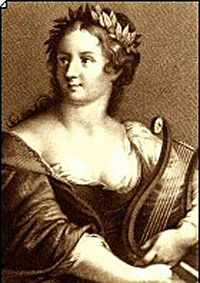Gaspara Stampa

Gaspara Stampa (1523 – 23 April 1554) was an Italian poet. She is considered to have been the greatest woman poet of the Italian Renaissance, and she is regarded by many as the greatest Italian woman poet of any age.[1]
Biography
Born in Padua, Stampa's father, Bartolomeo, originally from Milan, was a jewel and gold merchant in Padua. When Stampa was eight, her father died and her mother, Cecilia, moved to Venice with her children Gaspara, Cassandra, and Baldassarre; whom she educated to literature, music, history, and painting. Gaspara and Cassandra excelled at singing and playing the lute, possibly due to training by Tuttovale Menon. Early on, the Stampa household became a literary club, visited by many well-known Venetian writers, painters and musicians.
When her brother died in 1544, Stampa suffered greatly and formed the intention of becoming a nun. However, after a long period of crisis, she came back to "la dolce vita" (the sweet life) in Venice, and was believed to have been involved in a love affair with Count Collaltino di Collalto. It was to him that she eventually dedicated most of the 311 poems she is known to have written. The relationship broke off in 1551, apparently resulting from a cooling of the count's interest, and perhaps in part due to his many voyages out of Venice. Stampa was devastated.
Stampa went into a physical prostration and depression, but the result of this period is a collection of beautiful, intelligent and assertive poems in which she triumphs over Collaltino, creating for herself a lasting reputation. It might be noted in passing that Collaltino is only remembered because of Stampa. She makes clear in her poems that she uses her pain to inspire the poetry, hence her survival and fame. After Collaltino, Stampa had another lover and may not have been a courtesan as some believe. There is evidence that she was a musician who performed madrigals of her own composition.
In 1550 Stampa became a member of the Accademia dei Dubbiosi under the name of “Anaxilla.” Toward the end of the year Collaltino returned to Venice, and Stampa spent time with him at his estate, but by the end of the year, deeply depressed, she returned to Venice, marking the end of her relationship with Collaltino and the beginning of a new relationship with Bartolomeo Zen.
Between 1551 and 1552, Stampa enjoyed a period of relative tranquillity. But the following year her health worsened, and she spent a few months in Florence hoping that the milder climate might cure her. She then returned to Venice, became ill with a high fever, and after fifteen days she died on April 23, 1554.
The register of her parish noted that she died of fever and colic, and of mal de mare (Venetian for "disease of the sea"). In October 1554, Pietrasanta published the first edition of Stampa’s poetry, edited by her sister Cassandra. Her poems were published posthumously in the collection, Rime.
Literature
Stampa's collection of poems has a diary form: Gaspara expresses happiness and emotional distresses, and her 311 poems are one of the most important collections of female poetry of the 16th century. This collection was published after her death by her sister Cassandra, and dedicated to Giovanni Della Casa.
The German poet, Rainer Maria Rilke, refers to Gaspara Stampa in the first of his Duino Elegies; which is often considered his greatest work.
References
- Gaspara Stampa (c.1523-1554), Other Women's Voices, Retrieved on April 17, 2008
- Stampa, Gaspara (2010). The Complete Poems: The 1554 Edition of the "Rime," a Bilingual Edition. Jane Tylus (trans.). Chicago, Illinois: University of Chicago Press. ISBN 978-0-226-77071-0.
- Stefano Bianchi, La scrittura poetica femminile nel Cinquecento veneto: Gaspara Stampa e Veronica Franco, Manziana: Vecchiarelli, 2013. ISBN 978-88-8247-337-2
- Stampa, Gaspara; Lillie, translated by Laura Anna Stortoni & Mary Prentice (1994). Laura Anna Stortoni and Mary Prentice Lillie, ed. Gaspara Stampa: Selected Poems. New York: Italica Press. ISBN 0934977372.
External Sources
- Some of Gaspara Stampa's poems can be read here: http://oldpoetry.com/oauthor/show/Gaspara_Stampa
- Stampa's works are also included in Harold Bloom's Western Canon, Italy: http://home.comcast.net/~dwtaylor1/aristocraticcanon.html
Citations
|